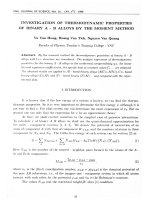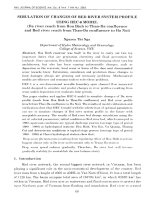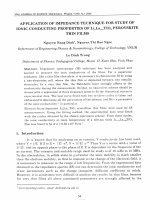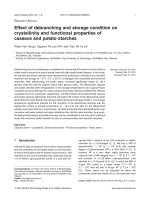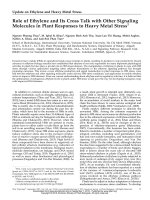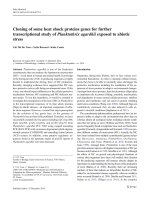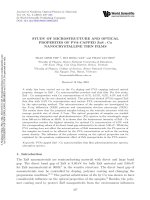DSpace at VNU: Utilization of soil properties to understand the vertical distribution of dioxins in the soil of Bien Hoa airbase, Vietnam
Bạn đang xem bản rút gọn của tài liệu. Xem và tải ngay bản đầy đủ của tài liệu tại đây (825.79 KB, 8 trang )
Environ Earth Sci (2016) 75:18
DOI 10.1007/s12665-015-4803-y
ORIGINAL ARTICLE
Utilization of soil properties to understand the vertical
distribution of dioxins in the soil of Bien Hoa airbase, Vietnam
Thuong Huyen Dang1 • Toshifumi Igarashi2 • Takuya Shiraiwa3
Received: 13 March 2015 / Accepted: 8 July 2015 / Published online: 19 December 2015
Ó Springer-Verlag Berlin Heidelberg 2015
Abstract During the Vietnam War, Bien Hoa airbase was
utilized by the US military in the storage and transport of
Agents Orange, White, and Blue, which are herbicides/
defoliants used during the war. These chemicals used were
highly contaminated with dioxins, which were still
unknown at that time as carcinogenic chemicals. Thus,
accidental spills as well as deliberate disposal of contaminated items within the airbase caused the advertent dioxin
problem of the airbase. The relationships of soil properties
and dioxin distribution have not yet been considered at this
site. Therefore, the objective of this paper was to clarify
these relationships using soil samples from boring cores
drilled from three areas of the airbase. Dioxins concentrations, total organic carbon (TOC), loss on ignition (LOI),
and grain size distribution were analyzed. The results
showed that dioxin concentration increased with the
increase in TOC. Silty clay with higher TOC of 0.49 %
presented the highest toxicity equivalency quantity (TEQ)
of 3300 pg-TEQ/g-dw at borehole BH01. Similarly, at
BH02, silty clay with the highest TOC of 0.42 % showed
the highest TEQ of 760 pg-TEQ/g-dw. The analyzed
results of this research also presented a relationship
between the TEQ and particle size. It seems to show that
& Thuong Huyen Dang
1
Earth Resources and Environment Department, Faculty of
Petroleum and Geology Engineering, Ho Chi Minh City
University of Technology, 106 Blg8, 168 Ly Thuong Kiet,
Dist.10, Ho Chi Minh City, Vietnam
2
Faculty of Engineering, Hokkaido University, Kita-ku,
Sapporo 060-8628, Japan
3
Yagai-Kagaku Co., Ltd., Higashi-ku, Sapporo 065-0043,
Japan
the higher concentration of dioxins was found with a ratio
of coarse grain size to fine grain size approximately 1:1.
However, correlation between dioxins and LOI was not
clearly observed. This indicates that mobility of dioxins is
sensitive to the TOC of soils.
Keywords Dioxins Á Soil Á Toxicity equivalency quantity
(TEQ) Á Grain size distribution Á Total organic carbon
(TOC) Á Loss on ignition (LOI)
Introduction
Polychlorinated dibenzo-p-dioxins and polychlorinated
dibenzofurans (PCDD/Fs) are groups of organic compounds generally referred to us ‘‘dioxins and dioxin-like
substances.’’ They have characteristic two- or three-ring
benzene structures that can be chlorinated to varying
degrees (Heidelore 2003). Humans can be exposed to these
organic substances either directly or indirectly via the
consumption of contaminated food crops and animal
products (Elskens et al. 2013). Dioxins and dioxin-like
substances could cause cancer, developmental and neurodevelopmental defects in children, immunotoxicity, and
changes in thyroid and steroid hormones (WHO 2002;
FAO/WHO 2006). Dioxins and dioxin-like compounds are
also considered as cumulative poisons, i.e., the human
body does not have the ability to excrete these substances
out; therefore, they slowly accumulate with continuous
exposure to contaminate food sources. PCDD/Fs are
formed industrially as by-products in the manufacture of
chlorophenols and phenoxy herbicides, chlorine bleaching
of paper pulp and smelting. They can also be formed naturally due to natural events like forest/bush fires and volcanic eruptions (Rappe et al. 1987; Rappe 1996). These
123
18
Page 2 of 8
chemicals are persistent organic pollutants; and because of
their inherent stability and hydrophobicity, these compounds could migrate for long distances overtime (Altarawned et al. 2009; Bergknut et al. 2010).
During the Vietnam War, Agent Orange, a herbicide/
defoliant named after the orange-striped barrels in which it
was shipped, was used by the US military in the herbicidal
warfare campaign code named ‘‘Operation Ranch Hand.’’
More than 22.67 million liters, 9.36 million liters, and 3.39
million liters, respectively, of Agent Orange, Agent White,
and Agent Blue had been transported and stored by the
Ranch Hand in Vietnam War (US DOD 2007; Young and
Andrews 2007). The most widely used of these agents was
Orange. The aim of this program was to deprive the
VietCong of food and vegetation cover in the thick jungles
of southern Vietnam (Buckingham 1982). Agent Orange is
a mixture of 50 % 2,4-dichlorophenoxyacetic acid (2,4-D)
and 50 % 2,4,5-trichlorophenoxyacetic acid (2,4,5-T),
which was the most extensively used herbicide/defoliant in
this campaign (Buckingham 1982; Paul 2002). By the end
of the Vietnam War in 1971, the US military reportedly
used ca. 45 million liters of Agent Orange, which was
sprayed within at least 6 million acres (24,000 km2) of
farm and forest areas in southern Vietnam (Buckingham
1982). The persistence of 2,4-D and 2,4,5-T in soil is
limited to only a few weeks, and high dosages are necessary for these substances to have detrimental effects to
humans (Buckingham 1982). Unfortunately, 2,4,5-T used
in the production of Agent Orange was contaminated with
2,3,7,8-tetrachlorodibenzodioxin (TCDD), an extremely
toxic PCDD compound (Buckingham 1982). As a result,
large farming and forest areas, including the air bases used
for their storage and transport, were inadvertently contaminated with this very toxic organic compound.
According to the Vietnam Red Cross, ca. 3 million Vietnamese are currently affected by dioxins, including at least
150,000 children born with birth defects (Michael 2012). In
addition, women had higher rates of miscarriage and
stillbirths in the dioxin-contaminated areas, as did livestock
such as cattle, water buffalo, and pigs. Children born in
these contaminated areas also have multiple birth defects,
including cleft palate, mental disabilities, hernias, and extra
fingers and toes (Hermann 2006).
Vertical distribution of PCDD/Fs in sediment cores was
also observed above the groundwater level, indicating that
they are transported downwards by percolating
rain/groundwater (Czucwa et al. 1984). Kakimoto et al.
(2006) showed that dioxins in soils are re-mobilized by
dilution when irrigation in rice fields was increased. The
decrease in dioxins concentration in soil core had been
presented in research of Bergknut et al. (2010). Bulle et al.
(2011) and Dang et al. (2015) also studied on the degradation of dioxins according to depth in Bien Hoa airbase.
123
Environ Earth Sci (2016) 75:18
Brzuzy and Hites (1996) found strong correlations between
total PCDD/Fs levels in soil and the content of total organic
carbon (TOC), while Kim and Osako (2004) showed that
the leaching concentration of dioxins correlated with dissolved organic carbon in situ using lysimeter. Although
strong correlations between TOC and PCDD/Fs in soils
have been reported, correlation analyses revealed no significant relationship between TOC and TEQ of ball clay in
the studies of Hilscherova and Kanan (2003) and Ferrario
et al. (2007).
Surveys of PCDD/Fs concentrations of Bien Hoa airbase, one of the air bases used by the US military during
the Vietnam War for their herbicidal campaign program,
have been conducted several times but were limited to the
analyses of surface soils only (Hatfield Consultants and
10-80 Committee 2006, 2007, 2011). Because PCDD/Fs
could migrate downward and contaminate the groundwater,
these previous surveys are insufficient to gage the actual
scale of dioxin contamination of the area. Therefore,
detailed surveys of deeper soils and sediments should be
conducted to understand the risks associated with dioxin
contamination of the area as well as to understand the
migration pattern(s) of dioxin in the subsurface satisfactorily. In this paper, the authors attempt to characterize the
mobility of PCDD/Fs as functions of soil properties by
drilling three boreholes and taking undisturbed soil cores in
the airbase.
Study site and methods
Study site
The study area is located in Bien Hoa city of Dong Nai
province (Fig. 1). Bien Hoa airbase is very close (ca.
500 m) to the Dong River, which is the primary water
source of water for residents of Dong Nai province, Ho Chi
Minh City, and other provinces. The elevation of the airbase is higher than its surrounding areas, so groundwater
and surface run off with substantial concentrations of
dioxins flow from the airbase to Bien Hung Lake, Dong
Nai River, and residential areas (Dang et al. 2015).
Surveys of dioxins have been done since 2001 (Dwernychuk et al. 2002; Dwernychuk 2005: Hatfield Consultants and 10-80 Committee 2006, 2007, 2011), but these
were limited to the shallow ground surface ([10 cm). Some
soil samples showed several thousand times higher dioxin
concentrations than the Vietnamese standards. These
reports recommended that the contaminated soils be treated
immediately in the airbase (Vu-Anh et al. 2008, Hatfield
Consultants and 10-80 Committee 2006, 2007, 2011).
According to the information from a present department
commander and Hatfield Consultants and 10-80 Committee
Environ Earth Sci (2016) 75:18
Page 3 of 8 18
Fig. 1 The Bien Hoa airbase (achieved from Dang et al. 2015)
(2006, 2007, 2011), Bien Hoa airbase has three hot spot
zones. The first is Pacer Ivy with an area of 20 ha, which
was used as a garrison and dumpsite of soldiers’ used
clothes. The highest concentration of TEQ measured in this
area was 28,600 pg-TEQ/g-dw. The previous research also
showed that at a depth of 3.6 m the highest concentration
of dioxins was 3300 pg-TEQ/g-dw in the Pacer Ivy (Dang
et al. 2015). The second is in the Southwest Corner of the
airbase (known as football stadium) with an area of ca.
1.2 ha and was formerly used as an infirmary of wounded
soldiers. The highest concentration of TEQ in this area was
65,500 pg-TEQ/g-dw. The third is Z1 with an area of about
4.7 ha, which was used during the war as a storage area of
Agents Orange, White, and Blue. The highest concentration of TEQ in this area was 35,900 pg-TEQ/g-dw, which
is currently used as an isolated landfill site of 94,000 m3 of
contaminated soil.
Methods
Sampling
Three boreholes, BH01, BH02, and BH03, were drilled in
the study site to collect undisturbed soil samples. Two of
them were in the Pacer Ivy area, while the third one was in
the Southwest Corner of the airbase. Distances from BH01
to BH02 and from BH01 to BH03 are 170 and 1360 m,
respectively. The groundwater levels (GLs) were shallow:
GL-1.2 m at BH01, GL-1.1 m at BH02, and GL-5.1 m at
BH03. All of the cores were collected and transported to
the Ho Chi Minh City University of Technology. Four soil
samples at BH01 (BH01-1, BH01-2, BH01-3, and BH01-4)
were collected at depths of 1.95, 2.55, 3.5, and 5.65 m,
respectively. Soil samples of BH02-1, BH02-2, BH02-3,
and BH02-4 were collected at a depth of 0.65, 2.6, 3.6, and
5.5 m, respectively, at borehole BH02. The last four samples BH03-1, BH03-2, BH03-3, and BH03-4 were collected at depth of 0.55, 2.5, 4.45, and 6.4 m, respectively,
at borehole BH03. Twelve undisturbed soil samples with
approximately 5 cm in thickness were collected based on
visual differences in soil texture. These samples were then
sealed with aluminum foil and sent to Japan for analysis.
The sampling process had been presented in research of
Dang et al. (2015).
Chemical analysis
Dioxins in soil samples were measured based on the
Japanese standard analytical method (Ministry of Environment 2009) as shown in Fig. 2. After drying soil samples under room temperature, eight grams were placed in a
thimble filter and then treated by Soxhlet extraction using
toluene for more than 16 h (part A in Fig. 2). The extracted
crude solvent was evaporated, messed up to 100 ml, and
divided into several aliquots (i.e., primarily by 0.1 ml and
secondary by 90 ml). After adding internal standards as a
clean-up spike in the separated solvent, the aliquot was
evaporated, replaced to hexane, injected into a multilayer
column chromatograph with normal hexane (part B in
Fig. 2) (Dang et al. 2015).
After the elution, effluent from the multilayer column
chromatograph was evaporated again, and the resulting
product was injected into an active charcoal column
chromatograph first with hexane, followed by 25 %
dichloromethane/hexane (for mono-ortho PCBs fraction),
and then finally with toluene (for non-ortho PCBs fraction
and PCDD and PCDFs). Each eluted fraction for analysis
was purged by N2 gas to approximately 50 ll and taken in
123
18
Page 4 of 8
Environ Earth Sci (2016) 75:18
sample
Soxhlet extraction
(A)
concentration
with toluene for over 16hrs
removal of toluene
add Internal Std. (clean-up spike)
C-2,3,7,8 located -T4 O8CDD
13
crude extract
13
C-2,3,7,8 located -T4 O8CDF
13
C-Co-PCBs
division
Options; treating with sulfuric acid
concentration
Removal of toluene
replace to n-hexane
(B)
Multi-layer silicagel column chromatography
Sodium sulfate (dehydrates) 6.0g
10% Silver nitrate silicagel 3.0g
Silicagel 0.9g
22% Sulfuric acid silicagel 6.0g
44% Sulfuric acid silicagel 4.5g
Silicagel 0.9g
2% Potassium hydroxide silicagel 3.0g
Silicagel 0.9g
elution with n-hexane
concentration
Active charcoal silicagel column chromatography
elution with n-hexane
aliphatic
hydrocarbons
PCBs etc. Fr.
elution with 25% DCM/n-hexane
elution with toluene
(C)
mono-ortho PCBs Fr.
PCDDs, PCDFs
non-ortho PCBs Fr.
concentration
waste
concentration
addition of syringe spike
exchange to n-nonane volume
HRGC/HRMS
mono-ortho PCBs
Idn. and Qnt. by SIM
(D)
50μl
addition of syringe spike
exchange to n-nonane volume
50μl
HRGC/HRMS
PCDDs, PCDFs and non-ortho PCBs
Idn. and Qnt. by SIM
Fig. 2 Analytical procedure flow chart (Idn. and Qnt. indicate identification and quantity, respectively in the figure, modified from Dang et al. 2015)
123
Environ Earth Sci (2016) 75:18
a vial bottle (part C in Fig. 2). The sample was provided for
a gas chromatograph–mass spectrometer (GC–MS, JEOL,
Japan). WHO-TEF (2006) for TEQ calculation was adopted (Dang et al. 2015).
Quality assurance and quality control (QA/QC)
To enhance the quality of analyzed data, the authors
checked a blank value regularly and analyzed the same
sample three times for evaluating the variability. In addition, the recovery of samples within 50–120 %, according
to the Japanese standard method, was calculated (Dang
et al. 2015).
Soil properties analysis
Three common soil properties were examined in this study
and compared with the distribution of PCDDs and PCDFs:
particle size distribution, TOC, and loss on ignition (LOI).
Particle size distribution was analyzed based on American Society for Testing and Materials D421 and D422
(ASTM D421 and D422). Gravel and sand particles are
typically measured using sieve analysis. A stack of sieves
with accurately dimensioned holes between a mesh of
wires is used to separate the particles into size bins. There
are various holes diameters such as 4.750, 2.000, 0.850,
0.4250, 0.25, 0.106, and 0.075 mm. The finer grain size
was analyzed by hydrometer analysis. The soil particles are
mixed with water and shaken to produce a dilute suspension in a glass cylinder, and then, the cylinder is left to sit.
Then, Stock’s law was applied to calculate the relationship
between sedimentation velocity and particle size for 0.02
and 0.005 mm.
The TOC was determined from the total carbon (TC) at
900 °C and total inorganic carbon (IC) at 450 °C with
phosphate solution using the TOC analyzer attached to a
solid sample combustion unit (TOC-VCSN-SSM-5000A,
Shimadzu Corporation, Japan). The LOI was measured by
the difference in weight before and after ignition at 600 °C
for 2 h.
Page 5 of 8 18
(370 pg-TEQ/g-dw) and BH01-2 (3300 pg-TEQ/g-dw)
were found with a ratio of coarse grain size to fine grain
size of 54.2:45.8 and 63.6:36.4, respectively, while lower
concentrations of dioxins in BH01-3 (52 pg-TEQ/g-dw)
and BH01-4 (1.8 pg-TEQ/g-dw) were found with 76.2:23.8
and 41.1:58.9 in the same borehole (BH01). In borehole
BH02, higher concentrations of dioxins in samples BH02-1
(320 pg-TEQ/g-dw), BH02-2 (450 pg-TEQ/g-dw), and
BH02-3 (760 pg-TEQ/g-dw) were found with ratios of
coarse grain size to fine grain size of 51.3:44, 53.5:39.7,
and 47.6:48.1, respectively. In borehole BH03, low concentrations of dioxins were found in four samples with
ratios of coarse grain size to fine grain size of 86.9:13.1,
90.5:9.5, 93:7, and 84.5:15.5 from shallow to deeper
borehole BH03. Therefore, the grain size distribution may
affect on the presence of dioxin in soil.
The highest concentration of dioxins was observed
below the groundwater table (Table 1). At borehole BH01,
the groundwater table was 1.2 m deep, while the highest
dioxin concentration of BH01-2 (3300 pg-TEQ/g-dw) was
found at a depth of 2.55 m. Similarly, at borehole BH02,
groundwater table was located at GL-1.1 m, whereas the
highest concentration of dioxins was observed at a depth of
3.6 m. Even though dioxins are generally considered as
relatively immobile in soils due to the presence of organic
matter, they can, nonetheless, flow slowly to downstream
in shallow groundwater and induce risks to surrounding
habitats (Kurniawan and Jinno 2007). This means that
dioxins from the airbase may move with the groundwater
flow downstream into Dong Nai River, which is only about
500 m away.
Results and discussion
TEQ and grain size
Figure 3 shows the relationship of TEQ and grain size
distribution. Concentration of dioxin is in good agreement
with regulation distribution of grain size. The presence of
dioxins in soil samples in which distribution of grain size
from coarse grain size to fine grain size is not much different is found with high concentration. In borehole BH01,
higher concentrations of dioxin in samples BH01-1
Fig. 3 Grain size distribution of 12 samples and relationship with
TEQ
123
18
Page 6 of 8
Environ Earth Sci (2016) 75:18
Table 1 Sampling depth and dioxin concentration of 12 samples
Bore hole
BH01
BH02
BH03
ID of core soil sample
1
2
3
4
1
2
3
4
1
2
3
4
Depth of sampling (m)
1.95
2.55
3.5
5.65
0.65
2.6
3.6
5.5
0.55
2.5
4.45
6.4
Water table depth (m)
1.2
1.1
5.2
2,3,7,8-TCDD (pg/g-dw)
360
3200
51
1.8
320
450
750
4.4
32
0
4.3
0
TEQ (pg-TEQ/g-dw, ND = 0)
370
3300
52
1.8
320
450
760
4.4
32
0.011
4.3
0.0024
TOC (%)
0.52
0.49
0.2
0.04
0.37
0.32
0.42
0.06
0.26
0.06
0.03
0.02
LOI (%)
3.2
2.8
5.8
3.4
3.0
3.4
3.2
7.2
3.9
7.2
6.6
3.5
TEQ and TOC
TEQ and LOI
The results of TOC measurements are listed in Table 1.
TOC decreased with depth in boreholes BH01 and BH03.
The highest TOC is 0.52 % at a depth of 1.95 m of sample
BH01-1 and decreased with depth. BH03 had the same
distribution of TOC to that of BH01. However, almost
identically, the same TOC values were observed at a depth
of 0.65, 2.6, and 3.6 m of BH02.
The relationship between TOC and TEQ for all samples
is shown in Fig. 4. A statistically significant strong positive
correlation of TEQ with TOC was observed (R = 0.840;
p \ 0.005), indicating that the increase in TOC also corresponded to the increase in TEQ. Hilscherova and Kanan
(2003) pointed out that concentrations of PCDD/Fs in soils
and sediments were not correlated with TOC in sediments
or soils of Tittabawassee River, Michigan. However, the
presence of higher TOC indicates higher concentration of
dioxins in this site. Therefore, dioxins have a possibility to
accumulate in soil layers with higher TOC.
Figure 5 presents the relationship between LOI and TEQ.
Although it appears that a negative correlation exists
between TEQ and LOI, this relationship is not statistically
significant. These results are contradictory to the relationship between TOC and TEQ. Ozaki et al. (2005) also found
that TEQ concentration increased with LOI in sediment
samples. This may be due to the other materials contributing LOI except TOC.
Fig. 4 Relationship between TOC and TEQ
123
Conclusion
Undisturbed soil samples were collected by drilling three
boreholes in Bien Hoa airbase to analyze the vertical distribution of dioxins and soil properties. The high concentrations were observed with a ratio of coarse grain size and
fine grain size approximate 1:1 in each borehole. The
highest dioxin concentration was found 3300 pg-TEQ/g-
Fig. 5 Relationship between TEQ and LOI
Environ Earth Sci (2016) 75:18
dw with higher TOC of 0.49 % at the depth of 2.55 m at
borehole BH01, and 760 pg-TEQ/g-dw with the highest
TOC of 0.42 % at the depth of 3.6 m at borehole BH02.
However, there were not clear correlations between TEQ
and LOI. The TOC in the soil samples may control the
mobility of dioxins. The transference and absorption of
dioxins may be affected by TOC. The existence of high
TOC at deeper zones in the dioxin-contaminated areas is
important to evaluate the mobility of dioxins.
Acknowledgments The authors gratefully acknowledge the financial support from AUN/Seed-Net, permission from the Vietnam
Ministry of National Defense and Commander of Bien Hoa airbase
for taking sample collection, and permission from the Ministry of
Agriculture, Forestry and Fisheries of Japan for the importation of the
samples.
References
Altarawned M, Dlugogorski BZ, Kennedy EM, Mackie JC (2009)
Mechanisms for formation, chlorination, dechlorination and
destruction of polychlorinated dibenzo-p-dioxins and dibenzonfurans (PCDD/Fs). Prog Energy Combust Sci 35:245–274
Bergknut M, Laudon H, Wiberg K (2010) Dioxins, PCBs, and HCB in
soil and peat profiles from a pristine boreal catchment. Environ
Pollut 158:2518–2525
Brzuzy LP, Hites RA (1996) Global mass balance for polychlorinated
dibenzo-p-dioxins and dibenzofurans. Environ Sci Technol
30:1797–1804
Buckingham WA Jr (1982) The air force and herbicides in Southeast
Asia (1961–1971). Office of Air Force, United States Air Force,
Washington
Bulle CSM, Samson R, Descheˆnes L (2011) Transport of chlorinated
dioxins and furants in soil columns: modeling pentachlorophenol
pole-treating oil influence. Chemosphere 83:117–123
Czucwa JM, McVeety BD, Hites RA (1984) Polychlorinated dibenzop-dioxins and dibenzofurans in sediment from Siskiwit Lake,
Isle Royale. Science 226:568–569
Dang TH, Igarashi T, Shiraiwa T (2015) Vertical distribution of
dioxins in soil of Bien Hoa Airbase, Vietnam. SpringerPlus
4:300
Dwernychuk LW (2005) Dioxin hot spots in Vietnam. Chemosphere
60:998–999
Dwernychuk LW, Cau HD, Hatfield CT, Boivin TG, Hung TM, Dung
PT, Thai ND (2002) Dioxin reservoirs in southern Vietnam: a
legacy of agent orange. Chemosphere 47:117–137
Elskens M, Pussemier L, Dumortier P, Van Langenhove K, Scholl G,
Goeyens L, Focant JF (2013) Dioxin levels in fertilizers from
Belgium: determination and evaluation of the potential impact
on soil contamination. Sci Total Environ 454–455:366–372
FAO/WHO (2006) Code of practice for the prevention and reduction
of dioxin and dioxin-like PCB contamination in foods and feeds.
Rome, Food and Agriculture Organization of the United Nations
and World Health Organization, Joint FAO/WHO Food Standards Programme, Codex Alimentarius Commission, CAC/RCP
62-2006
Ferrario J, Christian B, Schaum J (2007) Concentrations of polychlorinated dibenzo-p-dioxins in processed ball clay from the
United States. Chemosphere 67:1816–1821
Hatfield Consultants and 10-80 Committee (2006) Identification of
new agent orange/dioxin contamination hotspot in southern
Vietnam. Report and appendices. Hatfield Consultants Ltd.,
Page 7 of 8 18
West Vancouver, BC, Canada; 10-80 Committee, Hanoi,
Vietnam
Hatfield Consultants and 10-80 Committee (2011) Environmental and
human health assessment of dioxin contamination at Bien Hoa
Airbase, Vietnam. Report and appendices. Hatfield Consultants
Ltd., West Vancouver, BC, Canada; 10-80 Committee, Hanoi,
Vietnam
Hatfield Consultants and 10-80 Committee (Hatfield Consultants Ltd.
and Office 33) (2007) Assessment of dioxin contamination in the
environment and human population in the vicinity of Da Nang
Airport. Report prepared for the Ford Foundation, Hanoi,
Vietnam. Hatfield Consultants Ltd., West Vancouver, BC,
Canada; Office 33, Hanoi, Vietnam
Heidelore F (2003) Chapter 6 dioxins and furans (PCDD/PCDF). In:
Fiedler H (ed) The handbook of environmental chemistry, vol 3,
part O persistent organic pollutants. Springer, Berlin
Hermann KJ (2006) Killing me softly: how agent orange murders
Vietnam’s children. In: Political affairs. Retrieved 25 May 2014
Hilscherova K, Kanan H, Nakata N, Hanari N, Yamashita N, Bradley
PW, John MM, Taylor AB, John PG (2003) Polychlorinated
dibenzo-p-dioxin and dibenzofuran concentration profiles in
sediments and flood-plain soils of the Tittabawassee River,
Michigan. Environ Sci Technol 37:468–474
Kakimoto H, Oka H, Miyata Y, Yonezawa Y, Niikawa A, Kyudo H,
Tang T, Toriba A, Kizu R, Hayakawa K (2006) Homologue and
isomer distribution of dioxins observed in water samples
collected from Kahokugata Lagoon and inflowing rivers, Japan.
Water Res 40:1929–1940
Kim YJ, Osako M (2004) Investigation on the humidification of
municipal solid waste incineration residue and its effect on the
leaching behavior of dioxins. Waste Manag 24:815–823
Kurniawan B, Jinno K (2007) Numerical modeling for risk assessment of groundwater contamination under river and pumping
effects. J Environ Hydrol 15(12):1–13
Michael FM (2012) Vietnamese victims of agent orange and U.S.–
Vietnam relations. CRS report for congress
Ministry of Environment (2009). />manual/dojo-manual/main.pdf
Ozaki H, Taniguchi S, Takanami R, Shimomukai N, Hamasaki T,
Sugahara M, Giri RR (2005) Quantification of dioxin in the
sieved fraction of river sediment. Water Sci Technol
52(9):225–233
Paul LS (2002) The history of agent orange use in Vietnam—an
historical overview from the veteran’s perspective. United State–
Vietnam scientific conference on human health and an environment effects of agent orange/dioxins, Hanoi, Vietnam, 3–6
March
Rappe C (1996) Sources and environmental concentrations of dioxins
and related compounds. Pure Appl Chem 68(9):1781–1789
Rappe C, Andersson R, Bergquist P-A, Brohede C, Hansson M,
Kjeller L-O, Lindstrom G, Arklund S, Nygren M, Swanson SE,
Tysklind M, Wiberg K (1987) Overview on environmental fate
of chlorinated dioxins and dibenzofurans: sources, levels and
isomeric pattern in various matrices. Chemosphere 16(8/
9):1603–1618
US Department of Defense (DOD) (2007) Presentation made at the
second agent orange and dioxin remediation workshop, Hanoi,
Vietnam, 18–19 June 2007. Co-sponsored by US Department of
Defense and Vietnam Ministry of Defense
Vietnam Embassy in Japan. />nr070521170056/. Accessed 20 Aug 2014
Vu-Anh L, Tuyet-Hanh TT, Ngoc-Bich N, Duc-Minh N, Thanh-Ha N,
Minh-Son N (2008) Knowledge, attitude and practice of local
residents at Bien Hoa City–Vietnam on preventing dioxin
exposure
through
foods.
Organohalogen
Compd
70:000535–000538
123
18
Page 8 of 8
WHO (2002) Polychlorinated dibenzodioxins, polychlorinated dibenzofurans, and coplanar polychlorinated biphenyls. In: Safety
evaluation of certain food additives and contaminants. Geneva,
World Health Organization (WHO) Food Additives Series, No. 48
123
Environ Earth Sci (2016) 75:18
Young AL, Andrews WB (2007) The history, science and risks of
defoliants used in the Vietnam war. Environ Inf Syst Res
3:121–125


